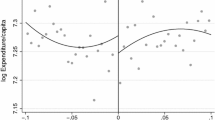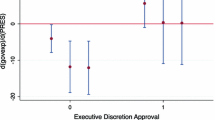Abstract
What is the influence of the rules of political representation on local spending? This research tests the law of 1/n in the Portuguese local context and finds that the law fails to apply. We suggest an alternative measure—the density of representation—to assess the impact of the rules of city council representation on local public expenditures. Density of representation is defined as the number of elected officials in the city council divided by city population. We find an S-shaped relationship between the density of representation and the level of local government expenditures. The level of municipal spending initially declines with increases in the density of representation, reflecting an increase in the ability of constituents to monitor their elected representatives. At higher levels of representation density, the relationship becomes positive, suggesting that the dynamics of the budgetary commons become salient. The relationship becomes negative again for extremely high density of representation owing to increases in the transaction costs of legislative decision-making. This paper discusses the implications of our findings for the reform of local government institutions and the rules of political representation.


Similar content being viewed by others
Notes
For the purposes of this manuscript, we use the terms ‘parish’ and ‘district’ interchangeably.
The municipalities of the archipelagos of Azores and Madeira were excluded owing both to the uniqueness of their geographical settings and missing data.
The results are omitted owing to space constraints, but are available from the authors upon request.
As an additional robustness check, Appendix B includes a table reporting models I–VI, estimated without the time trend variables. The results for our key theoretical variables of interest do not change substantively.
References
Aidt, T. S., & Shvets, J. (2012). Distributive politics and electoral incentives: evidence from seven US state legislatures. American Economic Journal: Economic Policy, 4(3), 1–29.
Azfar, O. (2001). The logic of collective action. In W. F. Shughart II & L. Razzolini (Eds.), The elgar companion to public choice (pp. 59–82). Cheltenham: Edward Elgar.
Baqir, R. (2002). Districting and government overspending. Journal of Political Economy, 110(6), 1318–1354.
Bradbury, J. C., & Crain, W. M. (2001). Legislative organization and government spending: Cross-country evidence. Journal of Public Economics, 82, 309–325.
Bradbury, J. C., & Stephenson, E. (2003). Local government structure and public expenditures. Public Choice, 115, 185–198.
Buchanan, J. M., & Tullock, G. (1962). The calculus of consent. Ann Arbor, MI: University of Michigan Press.
Buchanan, J. M., & Yoon, Y. J. (2002). Universalism through common access: An alternative model of distributive majoritarian politics. Political Research Quarterly, 55(3), 503–519.
Bulut, Y., & Taniyici, S. (2006). Representativeness and attitudes of municipal council members in Turkey: The case of Erzincan Province. Local Government Studies, 32(4), 413–428.
Clingermayer, J. C., & Feiock, R. C. (2001). Institutional constraints and policy choice: An exploration of local governance. Albany, NY: SUNY Press.
Coase, R. H. (1960). The problem of social cost. Journal of Law and Economics, 3(1), 1–44.
Cox, G. W. (1990). Multicandidate spatial competition. In J. Enelow & M. Hinich (Eds.), Advances in the spatial theory of voting. New York: Cambridge University Press.
Crain, W. M. (1999). Districts, diversity, and fiscal biases: evidence from the American states. The Journal of Law and Economics, 42(2), 675–698.
Crowley, G. R. (2015). Local intergovernmental competition and the law of 1/n. Southern Economic Journal, 81(3), 742–768.
Dixit, A., Grossman, G., & Helpman, E. (1997). Common agency and coordination: general theory and application to government policy making. Journal of Political Economy, 105, 752–769.
Drew, J., & Dollery, B. (2016). The price of democracy? Political representation structure and per capita expenditure in Victorian local government. Urban Affairs Review, Early View. https://doi.org/10.1177/1078087416629806.
Egger, P., & Koethenbuerger, M. (2010). Government spending and legislative organization: quasi-experimental evidence from Germany. American Economic Journal: Applied Economics, 2(4), 200–212.
Farnham, P. G. (1990). The Impact of Citizen Influence on Local Government Expenditure. Public Choice, 64(3), 201–212.
Feiock, R., MacDonald, L. & Ihlanfeldt, K. (2009). Housing values and the density of political representation at the local level, Florida State University (unpublished paper).
Ferejohn, J. (1986). Incumbent performance and electoral control. Public Choice, 50(1), 5–25.
Figueiredo, D., & Rui, J. P., Jr. (2003). Budget institutions and political insulation: why states adopt the item veto. Journal of Public Economics, 87(12), 2677–2701.
Fiorino, N., & Ricciuti, R. (2007). Legislature size and government spending in Italian regions: Forecasting the effects of a reform. Public Choice, 131(1–2), 117–125.
Gabrini, C. J. (2010). Do Institutions Matter? The Influence of Institutions of Direct Democracy on Local Government Spending. State and Local Government Review, 42(3), 210–225.
Gilligan, T. W., & Matsusaka, J. G. (1995). Deviations from constituent interests: The role of legislative structure and political parties in the states. Economic Inquiry, 33, 383–401.
Gilligan, T. W., & Matsusaka, J. G. (2001). Fiscal policy, legislature size, and political parties: Evidence from state and local governments in the first half of the 20th century. National Tax Journal, 54(1), 57–82.
Hajnal, Z. L., & Trounstine, J. (2010). Who or What governs? The effects of economics, politics, institutions, and needs on local spending. American Politics Research, 38(6), 1130–1163.
Halse, A. H. (2016). More for everyone: the effect of local interests on spending on infrastructure. European Journal of Political Economy, 43, 41–56.
Hendrick, R. M., Jimenez, B. S., & Lal, K. (2011). Does local government fragmentation reduce local spending? Urban Affairs Review, 47(4), 467–510.
Horn, M. J. (1995). The political economy of public administration: institutional choice in the public sector. Cambridge, MA: Cambridge University Press.
Keefer, P., & Knack, S. (2007). Boondoggles, rent-seeking, and political checks and balances: public investment under unaccountable governments. The Review of Economics and Statistics, 89(3), 566–572.
Langbein, L. I., Crewson, P., & Brasher, C. N. (1996). Rethinking ward and at-large elections in cities: Total spending, the number of locations of selected city services, and policy types. Public Choice, 88, 275–293.
Lee, D. (2015). Supermajority rule and the law of 1/n. Public Choice, 164(3–4), 251–274.
Lindberg, S. I. (2013). Mapping accountability: core concept and subtypes. International Review of Administrative Sciences, 79(2), 202–226.
MacDonald, L. (2008). The impact of government structure on local public expenditures. Public Choice, 136, 457–473.
Miller, G. J. (2005). The political evolution of principal-agent models. Annual Review of Political Science, 8, 203–225.
Moe, T. M. (1984). The new economics of organization. American Journal of Political Science, 28, 739–777.
Mohtadi, H., & Roe, T. L. (2003). Democracy, rent seeking, public spending and growth. Journal of Public Economics, 87(3), 445–466.
Morgan, D. R., & Kickham, K. (1999). Changing the form of county government: Effects on revenue and expenditure policy. Public Administration Review, 59(4), 315–324.
Mukherjee, B. (2003). Political parties and the size of government in multiparty legislatures. Comparative Political Studies, 36(6), 699–728.
Oliver, J. E. (1999). The effects of metropolitan economic segregation on local civic involvement. American Journal of Political Science, 43(1), 186–212.
Oliver, J. E. (2001). Democracy in Suburbia. Princeton, NJ: Princeton University Press.
Olson, M. (1965). The logic of collective action: public goods and the theory of groups. Cambridge: Harvard University Press.
Ostrom, E. (1990). Governing the commons. Cambridge, MA: Cambridge University Press.
Ostrom, E. (2000). The danger of self-evident truths, PS: Political Science and Politics, 33(1), 33–44.
Ostrom, E. (2005). Understanding institutional diversity. Princeton, NJ: Princeton University Press.
Park, J., McCabe, B. C., & Feiock, R. C. (2010). Direct democracy provisions and local government fiscal choices. The American Review of Public Administration, 40(4), 400–410.
Perotti, R., & Kontopoulos, Y. (2002). Fragmented fiscal policy. Journal of Public Economics, 86(2), 191–222.
Pettersson-Lidbom, P. (2012). Does the size of the legislature affect the size of government? Evidence from two natural experiments. Journal of Public Economics, 96(3), 269–278.
Primo, D. M. (2006). Stop us before we spend again: institutional constraints on government spending. Economics and Politics, 18(3), 269–312.
Primo, D. M., & Snyder, J. (2008). Distributive politics and the law of 1/n. Journal of Politics, 70(2), 477–486.
Raudla, R. (2010). Governing budgetary commons: what can we learn from Elinor Ostrom? European Journal of Law and Economics, 30, 201–221.
Raudla, R. (2015). The effects of electoral rules on public finances: Taking stock. In H. Peukert (Ed.), Taking up the challenge. Marburg: Metropolis.
Ricciuti, R. (2003). Trading interests: Legislature size, constituency size and government spending in a panel of countries. Rivista di Politica Economica. 93(1), 315–335.
Ricciuti, R. (2004). Political fragmentation and fiscal outcomes. Public Choice, 118(3–4), 365–388.
Sass, T. R. (1991). The choice of municipal government structure and public expenditures. Public Choice, 71(1), 71–87.
Shughart, W. F., & Tollison, R. D. (1986). The political economy of legislation and the growth of government. Research in Law and Economics, 9, 111–127.
Thornton, M., & Ulrich, M. (1999). “Constituency size and government spending. Public Finance Review, 27(6), 588–599.
Tiebout, C. M. (1956). A pure theory of local expenditures. Journal of Political Economy, 64(5), 416–424.
Tullock, G. (1959). Some problems of majority voting. Journal of Political Economy, 67(6), 571–579.
Tullock, G. (1967). The welfare costs of tariffs, monopolies, and theft. Western Economic Journal, 5, 224–232.
von Hagen, J. (2003). Budgeting institutions and public spending. In A. Shah (Ed.), Ensuring accountability when there is no bottom line. Handbook on public sector performance reviews (Vol. 1, pp. 36–73). Washington, DC: The World Bank.
Weingast, B. R., Shepsle, K. A., & Johnsen, C. (1981). The political economy of benefits and costs: a neoclassical approach to distributive politics. The Journal of Political Economy, 89(4), 642–664.
Acknowledgements
The authors would like to thank Richard Feiock and Tjerk Budding for the comments and suggestions. This research received funding from the project “SmartEGOV: Harnessing EGOV for Smart Governance (Foundations, methods, Tools)/NORTE-01-0145-FEDER-000037”, supported by Norte Portugal Regional Operational Programme (NORTE 2020), under the PORTUGAL 2020 Partnership Agreement, through the European Regional Development Fund (EFDR), from the Portuguese Science and Technology Foundation (Fundação para a Ciência e Tecnologia) [Grant No. PEst-OE/CJP/UI0758/2014], and from the Estonian Research Council Grant PUT-1142. Germà Bel thanks support by the Spanish Government under Project ECO2016-76866-R.
Author information
Authors and Affiliations
Corresponding author
Electronic supplementary material
Below is the link to the electronic supplementary material.
Rights and permissions
About this article
Cite this article
Bel, G., Raudla, R., Rodrigues, M. et al. These rules are made for spending: testing and extending the law of 1/n. Public Choice 174, 41–60 (2018). https://doi.org/10.1007/s11127-017-0488-y
Received:
Accepted:
Published:
Issue Date:
DOI: https://doi.org/10.1007/s11127-017-0488-y




